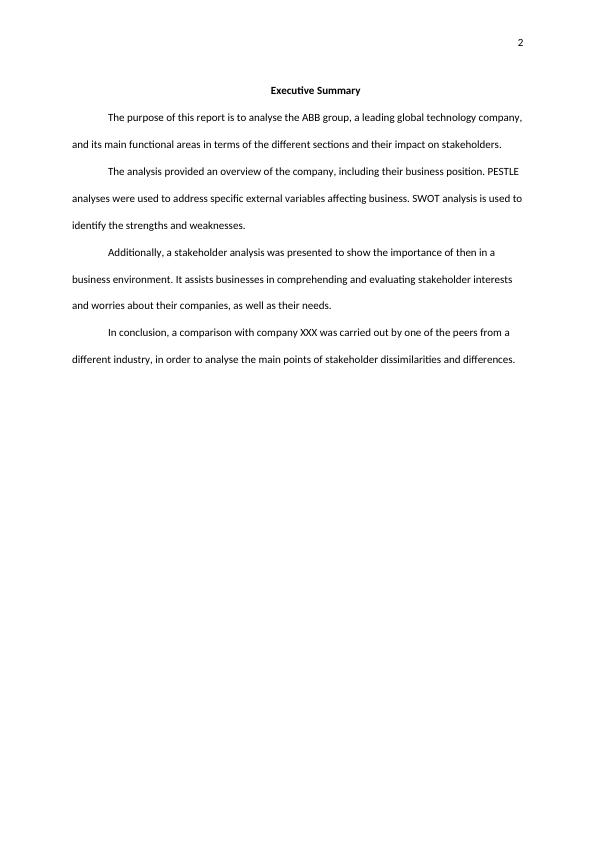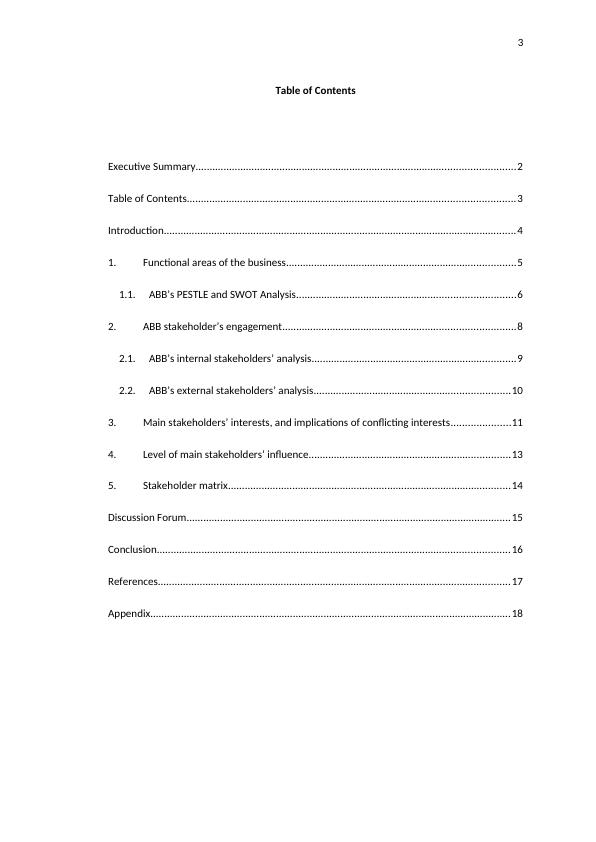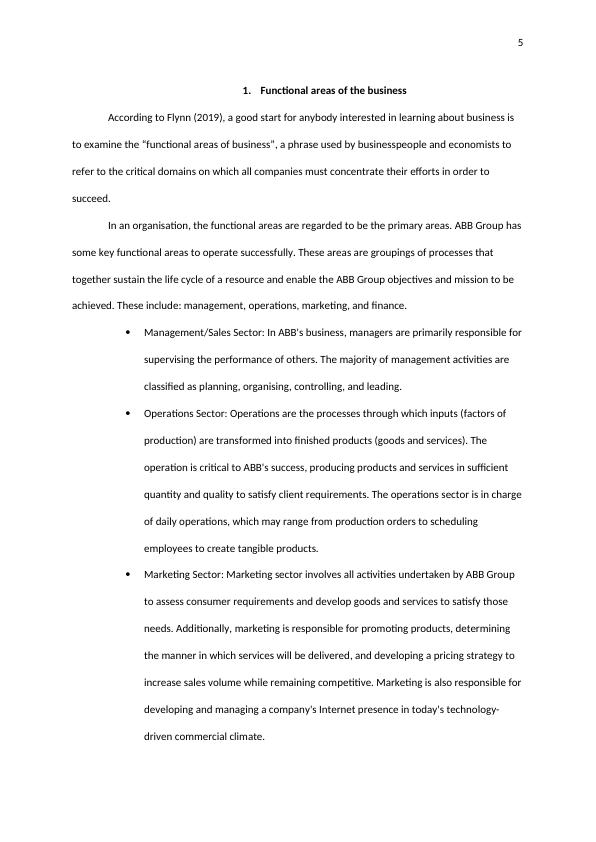MGT501 Contemporary Management
21 Pages3926 Words68 Views
Management Theory and Practice (MGT501)
Added on 2021-11-16
MGT501 Contemporary Management
Management Theory and Practice (MGT501)
Added on 2021-11-16
ShareRelated Documents
1
Assessment 2 – Internal and External Stakeholder Analysis
MGT501 – Business Environment
Assessment 2 – Internal and External Stakeholder Analysis
MGT501 – Business Environment

2
Executive Summary
The purpose of this report is to analyse the ABB group, a leading global technology company,
and its main functional areas in terms of the different sections and their impact on stakeholders.
The analysis provided an overview of the company, including their business position. PESTLE
analyses were used to address specific external variables affecting business. SWOT analysis is used to
identify the strengths and weaknesses.
Additionally, a stakeholder analysis was presented to show the importance of then in a
business environment. It assists businesses in comprehending and evaluating stakeholder interests
and worries about their companies, as well as their needs.
In conclusion, a comparison with company XXX was carried out by one of the peers from a
different industry, in order to analyse the main points of stakeholder dissimilarities and differences.
Executive Summary
The purpose of this report is to analyse the ABB group, a leading global technology company,
and its main functional areas in terms of the different sections and their impact on stakeholders.
The analysis provided an overview of the company, including their business position. PESTLE
analyses were used to address specific external variables affecting business. SWOT analysis is used to
identify the strengths and weaknesses.
Additionally, a stakeholder analysis was presented to show the importance of then in a
business environment. It assists businesses in comprehending and evaluating stakeholder interests
and worries about their companies, as well as their needs.
In conclusion, a comparison with company XXX was carried out by one of the peers from a
different industry, in order to analyse the main points of stakeholder dissimilarities and differences.

3
Table of Contents
Executive Summary..................................................................................................................2
Table of Contents.....................................................................................................................3
Introduction..............................................................................................................................4
1. Functional areas of the business..................................................................................5
1.1. ABB’s PESTLE and SWOT Analysis..............................................................................6
2. ABB stakeholder’s engagement...................................................................................8
2.1. ABB’s internal stakeholders’ analysis.........................................................................9
2.2. ABB’s external stakeholders’ analysis......................................................................10
3. Main stakeholders’ interests, and implications of conflicting interests.....................11
4. Level of main stakeholders’ influence........................................................................13
5. Stakeholder matrix.....................................................................................................14
Discussion Forum....................................................................................................................15
Conclusion..............................................................................................................................16
References..............................................................................................................................17
Appendix.................................................................................................................................18
Table of Contents
Executive Summary..................................................................................................................2
Table of Contents.....................................................................................................................3
Introduction..............................................................................................................................4
1. Functional areas of the business..................................................................................5
1.1. ABB’s PESTLE and SWOT Analysis..............................................................................6
2. ABB stakeholder’s engagement...................................................................................8
2.1. ABB’s internal stakeholders’ analysis.........................................................................9
2.2. ABB’s external stakeholders’ analysis......................................................................10
3. Main stakeholders’ interests, and implications of conflicting interests.....................11
4. Level of main stakeholders’ influence........................................................................13
5. Stakeholder matrix.....................................................................................................14
Discussion Forum....................................................................................................................15
Conclusion..............................................................................................................................16
References..............................................................................................................................17
Appendix.................................................................................................................................18

4
Introduction
ABB is a global leader in power and automation technology that helps utilities and industries
enhance efficiency while reducing environmental impact.
The ABB Group is divided into four segments: Electrification (working towards a future of
electrification that is safe, smart and sustainable electrification), Industrial Automation (working for
a future of safe and smart operations), Motion (Abb keeps the world moving while saving energy
every day.), and Robotics & Discrete Automation (working towards a future of flexible manufacturing
and intelligent machines) ("Our businesses", 2021).
Technology is very important to the ABB Success. ABB operates on a global scale, developing
innovative solutions that increase ABB clients' competitiveness while reducing environmental
impact. Sustainability, including technology, is incorporated in every part of ABB's operations. The
ABB Group provides a balance between economic, environmental, and social goals and to
incorporate these considerations into everyday business choices.
ABB's success is driven by nearly 110,000 outstanding workers in over 100 countries, with a
tradition of excellence over more than 130 years ("About ABB", 2021).
Introduction
ABB is a global leader in power and automation technology that helps utilities and industries
enhance efficiency while reducing environmental impact.
The ABB Group is divided into four segments: Electrification (working towards a future of
electrification that is safe, smart and sustainable electrification), Industrial Automation (working for
a future of safe and smart operations), Motion (Abb keeps the world moving while saving energy
every day.), and Robotics & Discrete Automation (working towards a future of flexible manufacturing
and intelligent machines) ("Our businesses", 2021).
Technology is very important to the ABB Success. ABB operates on a global scale, developing
innovative solutions that increase ABB clients' competitiveness while reducing environmental
impact. Sustainability, including technology, is incorporated in every part of ABB's operations. The
ABB Group provides a balance between economic, environmental, and social goals and to
incorporate these considerations into everyday business choices.
ABB's success is driven by nearly 110,000 outstanding workers in over 100 countries, with a
tradition of excellence over more than 130 years ("About ABB", 2021).

5
1.Functional areas of the business
According to Flynn (2019), a good start for anybody interested in learning about business is
to examine the “functional areas of business”, a phrase used by businesspeople and economists to
refer to the critical domains on which all companies must concentrate their efforts in order to
succeed.
In an organisation, the functional areas are regarded to be the primary areas. ABB Group has
some key functional areas to operate successfully. These areas are groupings of processes that
together sustain the life cycle of a resource and enable the ABB Group objectives and mission to be
achieved. These include: management, operations, marketing, and finance.
Management/Sales Sector: In ABB's business, managers are primarily responsible for
supervising the performance of others. The majority of management activities are
classified as planning, organising, controlling, and leading.
Operations Sector: Operations are the processes through which inputs (factors of
production) are transformed into finished products (goods and services). The
operation is critical to ABB's success, producing products and services in sufficient
quantity and quality to satisfy client requirements. The operations sector is in charge
of daily operations, which may range from production orders to scheduling
employees to create tangible products.
Marketing Sector: Marketing sector involves all activities undertaken by ABB Group
to assess consumer requirements and develop goods and services to satisfy those
needs. Additionally, marketing is responsible for promoting products, determining
the manner in which services will be delivered, and developing a pricing strategy to
increase sales volume while remaining competitive. Marketing is also responsible for
developing and managing a company's Internet presence in today's technology-
driven commercial climate.
1.Functional areas of the business
According to Flynn (2019), a good start for anybody interested in learning about business is
to examine the “functional areas of business”, a phrase used by businesspeople and economists to
refer to the critical domains on which all companies must concentrate their efforts in order to
succeed.
In an organisation, the functional areas are regarded to be the primary areas. ABB Group has
some key functional areas to operate successfully. These areas are groupings of processes that
together sustain the life cycle of a resource and enable the ABB Group objectives and mission to be
achieved. These include: management, operations, marketing, and finance.
Management/Sales Sector: In ABB's business, managers are primarily responsible for
supervising the performance of others. The majority of management activities are
classified as planning, organising, controlling, and leading.
Operations Sector: Operations are the processes through which inputs (factors of
production) are transformed into finished products (goods and services). The
operation is critical to ABB's success, producing products and services in sufficient
quantity and quality to satisfy client requirements. The operations sector is in charge
of daily operations, which may range from production orders to scheduling
employees to create tangible products.
Marketing Sector: Marketing sector involves all activities undertaken by ABB Group
to assess consumer requirements and develop goods and services to satisfy those
needs. Additionally, marketing is responsible for promoting products, determining
the manner in which services will be delivered, and developing a pricing strategy to
increase sales volume while remaining competitive. Marketing is also responsible for
developing and managing a company's Internet presence in today's technology-
driven commercial climate.

6
Finance: The finance sector is responsible for planning, acquiring, and managing
ABB's finances. ABB's finance department predicts economical capital needs and
assesses the loan's financial impact on the business. Additionally, the finance
department of a corporation provides answers to concerns regarding how money
should be obtained (loans vs stocks), the long-term cost of borrowing funds, and the
long-term impact of financing choices on the business's long-term health.
1.1.ABB’s PESTLE and SWOT Analysis
After identifying the main functional areas of the ABB group, PESTLE analysis will assist ABB
in identifying the significant external environmental factors that drive its strategy and competitor
analysis, and in assisting their strategic decision-making process. Conducting a PESTLE analysis is
essential to building successful strategies and meeting long-term development goals as ABB seeks to
extend and utilise its strengths and essential capabilities.
According to the first edition of The Pestle Analysis of the Perera (2017), Pestle analysis is a
useful management technique that companies employ to determine which macroeconomic aspects
they should address. The term PESTLE stands for Political, Economic, Social, Technological, Legal, and
Environmental. They serve as the foundation for identifying critical problems that may have an effect
on the company's strategic direction.
Political sector: Political considerations have a significant impact on ABB's lengthy
viability and earnings. The company's vulnerability to change in political contexts of multiple
countries is increased by its participation on the global scale. In a political way,
diversification of systematic risks is important for success in today's competitive global
corporate environment. A country's political environment is complex and diverse.
Economic sector: Economic variables such as currency rates, labour market,
inflation, and banking access, and many others, are important for ABB to understand since
they have an effect on the rate of capital environment. Thorough knowledge of the
Finance: The finance sector is responsible for planning, acquiring, and managing
ABB's finances. ABB's finance department predicts economical capital needs and
assesses the loan's financial impact on the business. Additionally, the finance
department of a corporation provides answers to concerns regarding how money
should be obtained (loans vs stocks), the long-term cost of borrowing funds, and the
long-term impact of financing choices on the business's long-term health.
1.1.ABB’s PESTLE and SWOT Analysis
After identifying the main functional areas of the ABB group, PESTLE analysis will assist ABB
in identifying the significant external environmental factors that drive its strategy and competitor
analysis, and in assisting their strategic decision-making process. Conducting a PESTLE analysis is
essential to building successful strategies and meeting long-term development goals as ABB seeks to
extend and utilise its strengths and essential capabilities.
According to the first edition of The Pestle Analysis of the Perera (2017), Pestle analysis is a
useful management technique that companies employ to determine which macroeconomic aspects
they should address. The term PESTLE stands for Political, Economic, Social, Technological, Legal, and
Environmental. They serve as the foundation for identifying critical problems that may have an effect
on the company's strategic direction.
Political sector: Political considerations have a significant impact on ABB's lengthy
viability and earnings. The company's vulnerability to change in political contexts of multiple
countries is increased by its participation on the global scale. In a political way,
diversification of systematic risks is important for success in today's competitive global
corporate environment. A country's political environment is complex and diverse.
Economic sector: Economic variables such as currency rates, labour market,
inflation, and banking access, and many others, are important for ABB to understand since
they have an effect on the rate of capital environment. Thorough knowledge of the

End of preview
Want to access all the pages? Upload your documents or become a member.
Related Documents
Strategic Management for ABB Ltd.lg...
|20
|4438
|322
External Business Environments Analysis of Aetna: PESTLE and SWOT Analysislg...
|6
|1158
|379
Pestle analysis of global business environmentlg...
|5
|758
|38
Strategic Management of Tesla: PESTLE, Porter's Five Forces, VRIO and Value Chain Analysislg...
|13
|3189
|479
Business Environment Assignment- Siemenlg...
|17
|4929
|195
PESTLE Analysis and Key Drivers of Change for Aston Martin in Global Business Environmentlg...
|5
|818
|498
